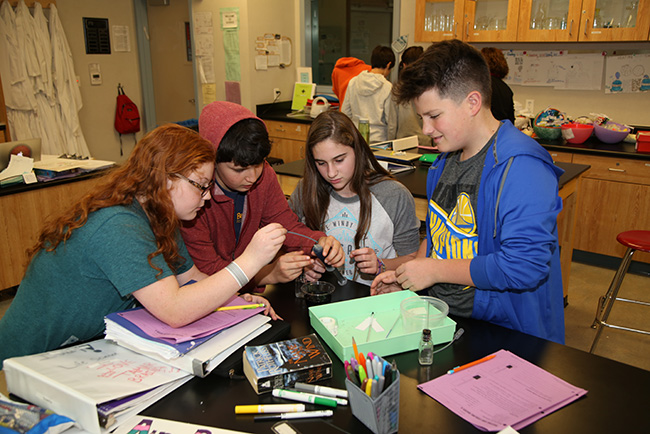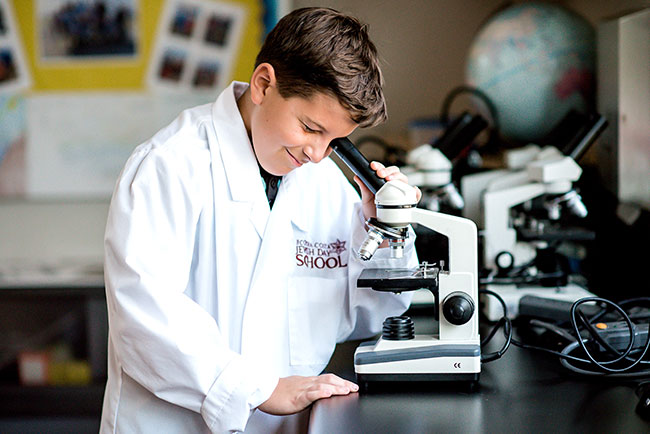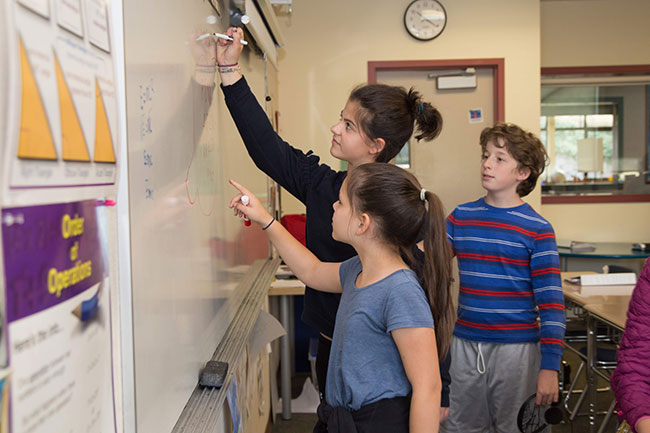STEM Programs

 Science – Technology – Engineering – Mathematics
Science – Technology – Engineering – Mathematics
CCJDS puts a high priority on innovative STEM education. We incorporate science and engineering projects at every grade level, kindergarten through eighth grade, with direct application to the real world.
Elementary STEM
In the elementary years, every classroom integrates at least three science units throughout the year: one life science unit, one earth science unit and one physical science unit. Students ask questions, design experiments, and collect data. For example, kindergartners learn about air by building and testing parachutes (physical science), students collect weather data (earth science) and students plant and observe different types of beans (life science). Fourth graders build circuit houses (physical science), plant and monitor a variety of plants in their garden (earth science) and build model habitats for a variety of ecosystems (life science). And, in every class, students engage in designing and revising projects that reflect engineering practices including the design and testing of fountains in kindergarten, the construction and testing of bridges in second grade, and the design of solar houses in fifth grade.
Middle School STEM
A strong STEM foundation is the launching pad for increasingly complex, deep and exciting work in middle school. Students continually ask questions and design experiments to answer those questions. Sixth graders study water quality by collecting and testing water samples from nearby sources, including the Lafayette Reservoir and Lake Temescal. Seventh graders learn about the human body by dissecting cow hearts, kidneys, and brains. They use this knowledge of anatomy to debate and discuss solutions to relevant problems including asthma in our community and the use of substances. Eighth graders learn about key physical science concepts like density by building and testing boats, chemical reactions by comparing gasoline combustion to hydrogen fuel cell combustion, and Newton’s Laws by building and testing bridges.
 Middle school students design their own science projects each year, which are presented at our annual Science Night. This is not the “typical” science fair project, but rather, a guided process of identifying an interesting question that contributes to Tikkun Olam (repairing our world), collecting data, analyzing the data, and presenting their findings to our larger community.
Middle school students design their own science projects each year, which are presented at our annual Science Night. This is not the “typical” science fair project, but rather, a guided process of identifying an interesting question that contributes to Tikkun Olam (repairing our world), collecting data, analyzing the data, and presenting their findings to our larger community.
We integrate technology all along the way and it is a critical component to our learning environment. Students routinely use laptops for research, writing and creating presentations, videos and websites. Technology, when used judiciously, greatly expands the reach of our classrooms by bringing engaging resources to the classroom including current news sources, movies, songs, and blogs. We also incorporate many WISE projects (Web-based Inquiry Science Environment) from the acclaimed National Science Foundation project developed by UC Berkeley (wise.berkeley.edu). WISE provides access to visualizations and simulations of complex scientific phenomena and helps bring these concepts to life. For example, seventh grade students watch and interact with a photosynthesis simulation since this is not something they can “see” in their plants. Eighth grade students interact with a chemical reaction visualization to “see” chemical reactions on a molecular level. Students also use “sensors” to collect temperature and motion data. Technology does not replace hands-on activities, but rather, extends what students and teachers can investigate and create.

Math skills are woven together with science throughout the CCJDS curriculum. All of our math units incorporate solving real life applications. Students at all grade levels learn to justify their solutions to complex math problems, as communication of ideas is a critical STEM skill. Students learn to present data in graphs, use metric and standard measurements, and apply algebra skills to better understand our physical world.
Our students report back to us that they feel very prepared moving into challenging high school settings and they enjoy their successive math, science and engineering classes.

